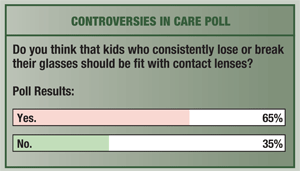 What parameters should we consider when fitting kids in contact lenses? Do you prefer daily disposables or silicone hydrogels? These were just a few of the topics our panelists, Christine Sindt, O.D., and Jeffrey Walline, O.D., Ph.D., tackled at last month’s “Controversies in Care” event, which drew in an audience of nearly 50 eye practitioners from across the country.
What parameters should we consider when fitting kids in contact lenses? Do you prefer daily disposables or silicone hydrogels? These were just a few of the topics our panelists, Christine Sindt, O.D., and Jeffrey Walline, O.D., Ph.D., tackled at last month’s “Controversies in Care” event, which drew in an audience of nearly 50 eye practitioners from across the country.
The evening’s first poll revealed that 50% of our respondents believed seven years was the appropriate age to fit kids with elective contact lenses. Dr. Sindt agreed, though she cited a recent study that said most practitioners are very comfortable fitting children in the 10 to 12 year age group.1
“I always say that we shouldn’t say what age people can be fit. We all know a five-year-old who is capable of contact lens wear and we all know a lot of 25-year-olds who are not,” said Dr. Walline.
The panelists argued that, since each patient is different, age shouldn’t be the deciding factor, but instead we should look at the parent involvement, maturity of the child and the motivation. When asked whether they would fit children who routinely lose or break their glasses, 35% of the audience respondents said they wouldn’t. This sparked a lively conversation on responsibility.
“I personally find that whether they clean their room or not has nothing to do with their motivation to wear lenses or their success with lenses,” said Dr. Sindt. “Usually all it requires is to sit down and have a very frank talk with the kid and see if they are willing to take on the responsibilities of having lenses.”
Drawing from a recent study that recorded the amount of time it took seven to 10 year olds versus teenagers to learn insertion and removal, Dr. Walline said he found a difference only at the extremes. “We shouldn’t not fit children in contact lenses because we think it’ll slow down the productivity of our office,” he said.
After discussing a few case studies, the panelists tackled the question of self-perception. Dr. Walline and colleagues did a study that ultimately found that contact lenses provided children with value-added benefits beyond simple vision correction, such as improved self-perception in the areas of athletic competence, physical appearance and peer interactions.
Dr. Sindt said that myopia control is the key issue for the next couple years and will help change the way practices work to capture patients who are not currently contact lens wearers. With every company having soft myopia control lenses launched worldwide, the U.S. market will soon follow. In the meantime, the panelists cited the connection between increased outdoor activity and decreased myopia.
The introduction and acceptance of daily disposable lenses as an option for kids, the availability of improved materials, the increase in requests from kids and parents for lenses and the flexibility allowed for activities and sports are all factors that account for a growing young contact lens wearing population.
Stay tuned next month for a lively discussion on daily disposables. We also welcome you to join the conversation live. You can register for upcoming online events at
www.reviewofcontactlenses.com.
1. Sindt C, Riley C. Practitioners attitude on children and contact lenses. Optometry. 2011 Jan;82(1):44-5.


